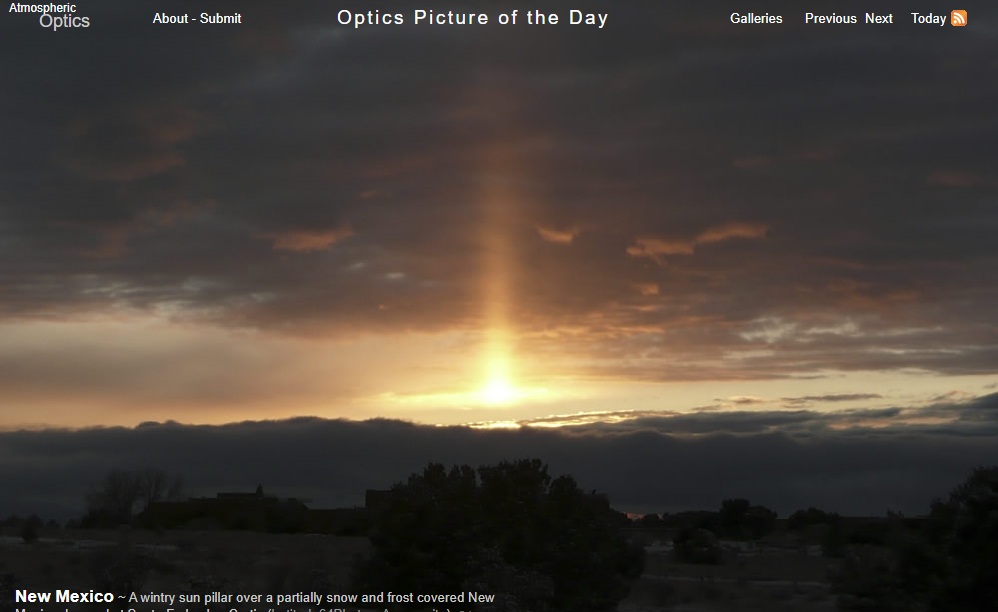New Mexico Pillar
New Mexico Pillar: A Phenomenon of Light
In the vast skies of New Mexico, a captivating atmospheric optical phenomenon known as a sun pillar occasionally graces the wintry landscape. These awe-inspiring pillars of light, resembling celestial columns, can be observed piercing through the horizon, creating a spectacle that delights both scientists and sky enthusiasts alike. Let's delve into the intricacies of the New Mexico Pillar and explore the science behind this mesmerizing display.
Understanding Sun Pillars
Sun pillars are optical phenomena that occur when sunlight interacts with ice crystals suspended in the atmosphere. These crystals can take the form of hexagonal plates or elongated columns, and their orientation plays a crucial role in the formation of sun pillars. When the crystals are oriented horizontally, such as when they are falling gently through the air, they act as tiny mirrors, reflecting sunlight and creating a vertical beam of light.
The Role of Weather Conditions
The formation of sun pillars requires specific weather conditions to align perfectly. In New Mexico, where cold winter temperatures and occasional snowfall are not uncommon, these conditions can be met. When the sun is low on the horizon during sunrise or sunset, its light passes through a thicker layer of Earth's atmosphere. This increased path length allows for a greater chance of encountering ice crystals, increasing the likelihood of observing a sun pillar.
The Dance of Light
As the sun's rays interact with the hexagonal ice crystals suspended in the air, they undergo a process known as refraction. This bending of light causes the rays to separate into different colors, similar to a prism effect. The result is a stunning display of vibrant hues stretching vertically above or below the sun. These colorful pillars of light can reach impressive heights, captivating observers with their ethereal beauty.
Unique Characteristics of the New Mexico Pillar
The New Mexico Pillar holds its own unique characteristics, distinguishing it from other sun pillars observed around the world. The partially snow and frost-covered landscape of New Mexico adds an enchanting touch to the phenomenon. The interplay between the sun's warm glow, the icy crystals, and the wintry surroundings creates a visually striking contrast that enhances the overall spectacle.
Capturing the New Mexico Pillar
Photographers and sky enthusiasts flock to New Mexico in hopes of capturing the breathtaking beauty of the sun pillar. With its picturesque landscapes and clear skies, the state offers a perfect backdrop for such endeavors. Photographers often venture to locations like Santa Fe, where they can frame the sun pillar against the stunning southwestern scenery, immortalizing this natural wonder through their lenses.
Beyond the New Mexico Pillar
While the New Mexico Pillar is undoubtedly a remarkable atmospheric phenomenon, it is not the only type of light pillar that can be observed. Similar phenomena, such as moon pillars and artificial light pillars, can also occur under specific conditions. Moon pillars are created when moonlight interacts with ice crystals, creating a similar vertical beam of light. Artificial light pillars, on the other hand, are produced by ground-based light sources reflecting off ice crystals in the air.
A Reminder of Nature's Wonders
The New Mexico Pillar serves as a reminder of the captivating wonders that nature bestows upon us. By understanding the scientific principles behind this optical phenomenon, we gain a deeper appreciation for the intricate workings of our atmosphere. Whether observed firsthand or captured through the lens of a camera, the New Mexico Pillar leaves an indelible mark on those fortunate enough to witness its ephemeral beauty.
Conclusion
The New Mexico Pillar stands as a testament to the harmonious interplay between sunlight and ice crystals in Earth's atmosphere. This captivating phenomenon enchants observers with its vertical beams of light and vibrant colors, adding a touch of magic to wintry landscapes. As we marvel at these natural wonders, let us continue to explore and appreciate the mysteries that unfold above us, forever fascinated by the beauty of the New Mexico Pillar and the countless other atmospheric phenomena that grace our skies.

New Mexico ~ A wintry sun pillar over a partially snow and frost covered New Mexico. Imaged at Santa Fe by Jan Curtis (Latitude64Photos, Aurora site). ©Jan Curtis, shown with permission.

Note: this article has been automatically converted from the old site and may not appear as intended. You can find the original article here.
Reference Atmospheric Optics
If you use any of the definitions, information, or data presented on Atmospheric Optics, please copy the link or reference below to properly credit us as the reference source. Thank you!
-
<a href="https://atoptics.co.uk/blog/new-mexico-pillar/">New Mexico Pillar</a>
-
"New Mexico Pillar". Atmospheric Optics. Accessed on November 26, 2024. https://atoptics.co.uk/blog/new-mexico-pillar/.
-
"New Mexico Pillar". Atmospheric Optics, https://atoptics.co.uk/blog/new-mexico-pillar/. Accessed 26 November, 2024
-
New Mexico Pillar. Atmospheric Optics. Retrieved from https://atoptics.co.uk/blog/new-mexico-pillar/.